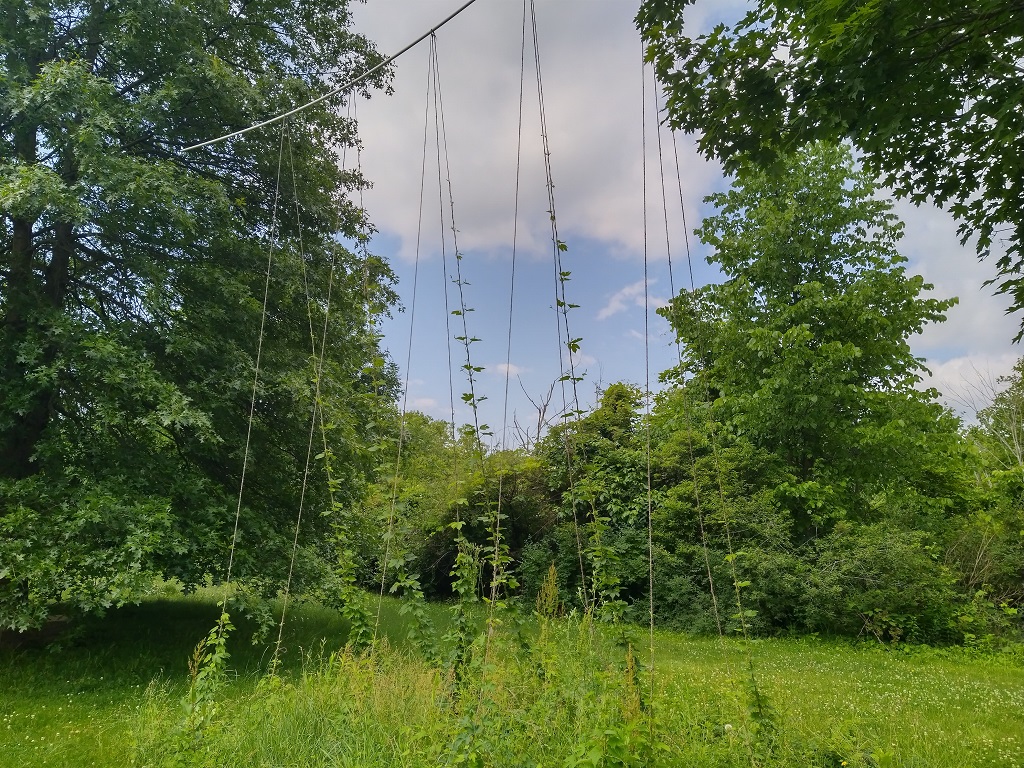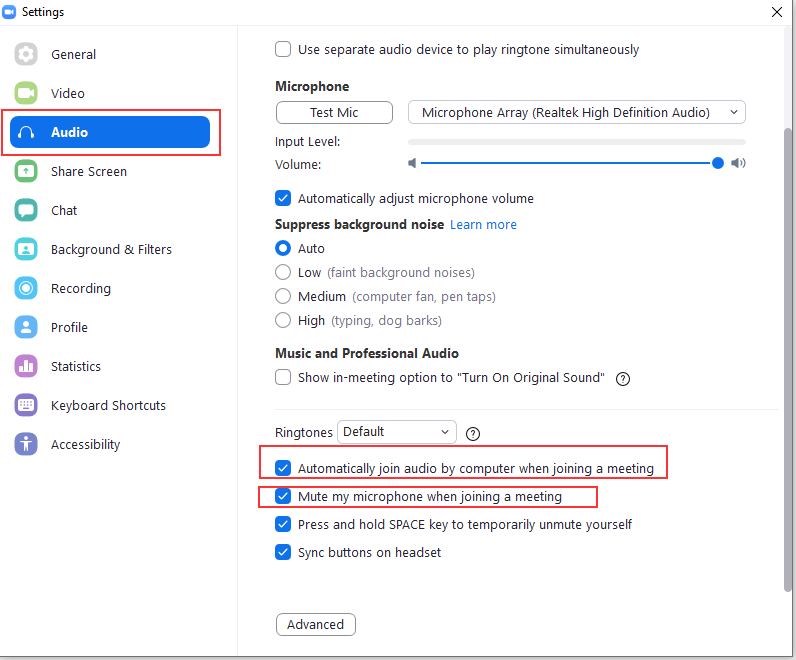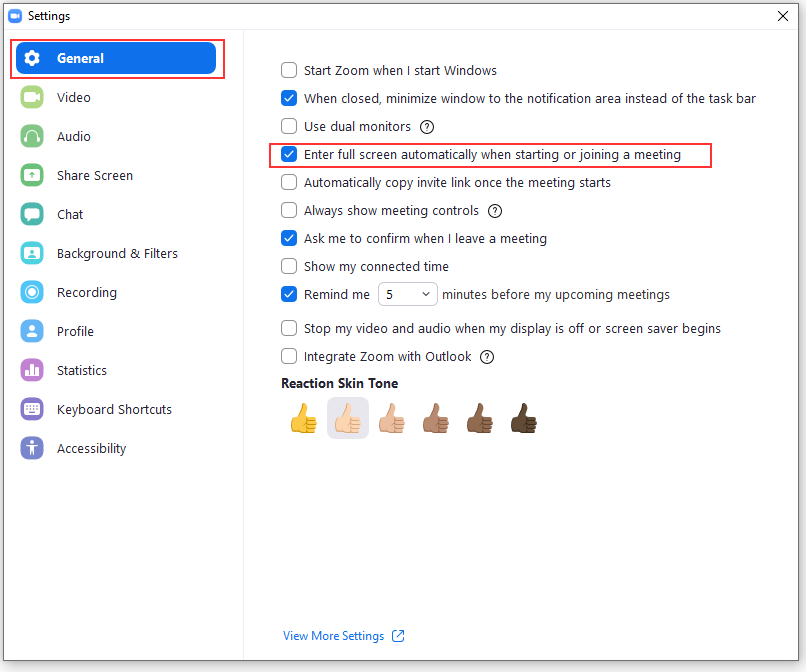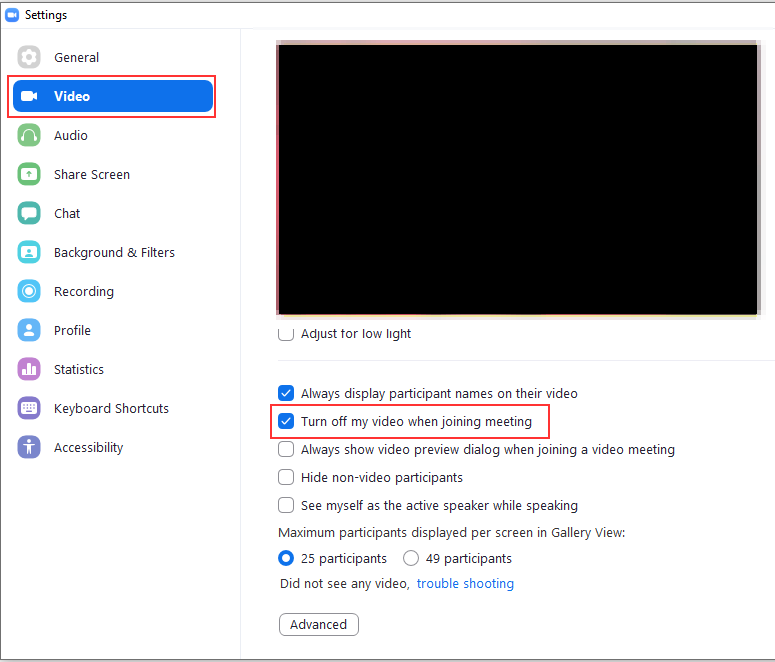The decoy garden is doing well — some of the plants have started to seed, and the radishes have little flowers. The real garden has started to sprout too — Anya’s seen rabbits munching on the decoy garden. Hopefully the deer do so too!
Author: Lisa
Trail Expansion
We’ve created a beautiful wood-chip covered trail in our woods — this has transformed the mucky maple harvest path into a usable trail and made collecting sap a lot quicker/easier (and less muddy!). This year, we’re working on extending the trail along the east side of our property. This will provide easier access to the maples in the back woods as well as the apiary. So far, I’ve cleared a bunch of honey suckle, multi-flora rose, wild raspberries, and general forest undergrowth. There’s a path angled off of the original path, a right hand turn, and a winding path along the eastern side of our property. Once we get it cleared, we collected a huge pile of wood chips from the Metro Parks this year that we’ll use to cover the trail.
2021 Hops
(Mostly) Fits In a Volt
Harbor Freight had one of their 20% off coupon sales for Fathers Day. We’ve been wanting to buy the 10×12 greenhouse for a while, and 20% off was the perfect opportunity to do so. There’s a site where someone details all of the tweaks they used to enhance the structure — we’ll be making a lot of these enhancements as we build the thing.
One of these days, we’ll have an electric farm truck running … but, until then, a 10×12 greenhouse in its box #FitsInAVolt … at least sufficiently to transport it a short distance home!
Adding MariaDB/MySQL Users
Quick notes on creating a database user — MariaDB and MySQL use a combination of username and source host to determine access. This means ‘me’@’localhost’ and ‘me’@’remotehost’ can have different passwords and privilege sets. How do you know what the hostname is for your connection? I usually try to connect and read the host from the error message — it’ll say ‘someone’@’something’ cannot access the database.
# Create a user that is allowed to connect from a specific host create user 'username'@'hostname' identified by 'S0m3P@s5w0rd'; GRANT ALL PRIVILEGES ON dbname.* TO 'username'@'hostname'; # Create a user that is allowed to connect from a specific IP create user 'username1'@'10.5.1.2' identified by 'S0m3P@s5w0rd'; GRANT ALL PRIVILEGES ON dbname.* TO 'username1'@'10.5.1.2'; # Create a user that is allowed to connect from database server create user 'username2'@'localhost' identified by 'S0m3P@s5w0rd'; GRANT ALL PRIVILEGES ON dbname.* TO 'username2'@'localhost'; # Create a user that is allowed to connect from any host create user 'username3'@'%' identified by 'S0m3P@s5w0rd'; GRANT ALL PRIVILEGES ON dbname.* TO 'username3'@'%'; # Flush so new privileges are effective flush privileges; # View list of database users SELECT User, Host FROM mysql.user; +----------------+------------+ | User | Host | +----------------+------------+ | username3 | % | | username2 | 10.5.1.2 | | username | hostname | | root | 127.0.0.1 | | root | ::1 | | root | localhost | +----------------+------------+ 6 rows in set (0.000 sec)
MariaDB Query Logging
Quick note on how to configure file-based query logging in MariaDB & turn query logging on and off:
SET GLOBAL general_log_file='/var/log/mariadb/query.log'; SET GLOBAL log_output = 'FILE'; -- Turn on query logging SET GLOBAL general_log = 'ON'; -- Turn off query logging SET GLOBAL general_log = 'OFF';
Civics Lesson – Federal and State Laws
Civics classes seem to do a good job of explaining the framework for federal and state government. The branches and processes are covered as well. But, ironically, there’s not much information about laws enacted/enforced by these governments. Sure, you know the legislature writes a bill, both houses vote to make it a law, and the head of the executive branch (president or governor) sign their agreement with the law to actually enact it. But … then what? How do people know what the laws actually are?
Laws are maintained in the “Code”. There’s a US Code and state code — e.g. Ohio Revised Code (ORC) in Ohio. At the federal level, there are also regulations in the Federal Register — this includes rules (and proposed rules) individual executive branch departments enact. It also contains executive orders. States maintain their own registers — the Ohio Register, for example. Now, someone may think rules / orders from the executive branch fall outside the scope of the law — and that person is welcome to bring a suit challenging the law. But, unless there’s an injunction or the regulation has been overturned … it’s still a rule you need to obey.
In addition to the laws enacted by congresses and regulations written by the executive branch, the American legal system is based on “common law” — basically what a court decides about a situation based on their reading and interpretation of the laws becomes guidance for future or down-level cases. Which is to say you can read the Ohio Revised Code front to back and still not have a complete understanding of the practical implementation of laws within Ohio.
Take, for example, ORC 519.02 which states that
Except as otherwise provided in this section, in the interest of the public health and safety, the board of township trustees may regulate by resolution, in accordance with a comprehensive plan, the location, height, bulk, number of stories, and size of buildings and other structures, including tents, cabins, and trailer coaches, percentages of lot areas that may be occupied, set back building lines, sizes of yards, courts, and other open spaces, the density of population, the uses of buildings and other structures, including tents, cabins, and trailer coaches, and the uses of land for trade, industry, residence, recreation, or other purposes in the unincorporated territory of the township
That’s pretty open ended. What is a comprehensive plan? If you’ve got a chapter in your zoning resolution that’s called “Comprehensive Plan” is that good enough [spoiler alert: it can be … see Central Motors Corp. v. City of Pepper Pike, 63 Ohio App.2d 34, 65 (8th Dist.1979)] or does the Township need to break that chapter out into its own “Comprehensive Plan” document? Who is involved in writing that plan, how often can it be updated, etc. These details emerge as someone says “hey, court, I don’t think this is right” and the court clarifies some detail of the Code.
So you’ve got federal laws, state laws, federal and state executive branch regulations, federal and state executive orders, and decisions made in court cases that make up “the rules”. Who do you complain to when you don’t like the rules?
Every time my daughter complains to me about being unable to drive, I tell her to write her state rep. Not because I particularly think the state rep is going to do anything, but “you have to be 16 to drive” is a state law. The only ones who can change a state law is the state legislature (I expect a federal driving age would be ruled unconstitutional, but starting at the federal level to change the ‘you only get our money if’ wouldn’t be a bad direction either. Sometimes the state has the law because federal funding is predicated on having the law — that’s how the drinking age got standardized across the country. But a state could, hypothetically, opt out of federal funding and do their own thing.)
What’s my point? If your township has some rule that you don’t like, there may not be much the Township Trustees can do about it. When the State Supreme Court has made a decision that creates a rule … you need to be talking to your state rep and senator to push to have that rule changed. They could pass a law that negates the court decision. Now someone could challenge the constitutionality of the new law in court … if the court deems the law unconstitutional, then the legislature could amend the state constitution too. When the federal government has created a regulation, you’d need to be talking to your federal rep and senators.
Bootleg Zoom Recordings
Our township has been holding meetings in Zoom, but the recordings are for the purpose of generating minutes only. It’s an end-run around document retention management (it’s not a record, so we don’t need to retain it) … but it also means residents cannot just catch the meeting whenever they’ve got time. In theory, it seemed easy enough to use a screen recording program (I use OBS Studio) to record the meetings. Problem is, though … I’m one of the people who isn’t generally available in the late afternoon / early evening when they schedule their meetings. Surely I could join the meeting early & just edit out the “dead air” within the recording …
(0) To configure Zoom client settings, you need to sign up for an account. Now that your client is signed in, there are settings.
(1) Audio isn’t automatically connected. In the settings window, under “Audio”, there is an option to automatically join computer audio. While you’re there, mute the mic when joining a meeting too.
(2) The window into which the main video is placed might be 2″ across. Under “General” is an option to use full screen when joining a meeting.
(3) Disable your video when joining the meeting — there’s no reason for anyone to stare at the wall behind my desk!
Hopefully these settings allow me to successfully record a Township meeting to watch later. In OBS Studio, I’ve got the audio input linked to my speakers and have the mic disabled as a recording source … this means someone talking near my computer doesn’t ruin my recording. There’s another meeting tomorrow … we’ll see if I’ve finally got it!
Update — this works unless the meeting organize throws up a “this meeting is being recorded” banner. In which case, you have a big dialog box in the middle of the meeting window. I give up, and we’ll just ensue someone’s at the computer to actually set up the recording.
Better Business Bureau
There are a few scenarios where the advertised protection a process offers are effectively worthless — Ebay disputes won’t refund shipping charges or require you to pay additional shipping to return an item, so shorting the customer by less than the shipping cost makes winning your dispute worthless. The 1970’s Fair Credit Billing Act gives you the right to dispute charges up to 60 days after the charge — but, when I ordered a CSA membership in September that started the following March … that window precluded a simple charge-back when the CSA claimed I was not on their list. I expect this window is why people get upset when companies finalize the charge before shipping the product.
Outside of the FCBA contest period, there’s not a whole lot you can do. Small claims could be a route, but that is less effective for inter-state transactions. Some company in Texas doesn’t really care that they’ve got a judgement against them in Ohio. Ohio doesn’t have a lot of power to force payment, either. Traveling to the state with more direct jurisdiction is expensive, and you’re not likely to reclaim damages incurred in obtaining the judgement (i.e. the settlement is not apt to cover your hundred dollar refund, three hundred dollar plane ticket, thousand dollars in hotel charges, and couple hundred bucks for a rental car).
That’s where we were with Keg Factory. We’d gotten a DigiBoil with an inaccurate temp reading. And been told by KegLand, the manufacturer, that the unit isn’t meant for mashing so isn’t designed to have an accurate temperature reading. (Asking why there’s a mashing kit for the not designed for mashing product didn’t yield any illuminating answer) … the owner of Keg Factory told us the product didn’t seem to be a good match for our needs (true, but the advertised function of the product certainly met our requirements!) and offered a shipping label to return the thing. Seemed like a good idea to stop wasting time on a product if the manufacturer says it’s not good enough for its intended purpose. We confirmed they weren’t looking to add a restocking fee or otherwise charge us — a full refund was what was on offer. Yup, that’s it. So we packed up the thing, shipped it off, and confirmed delivery. That was March. We proceeded to contact them looking for our refund. Calls routed to voicemail. No return e-mails. Online chat where we’re the next in queue for hours. When we did get through to someone, we’d be told someone would look at it that day. And still no refund.
As a last ditch effort, we filed a complaint with the Better Business Bureau. The Austin office concurred that our problem fell into their purview and forwarded the complaint on to the vendor. We got a refund notice within a few hours! It took a few days for the refund to clear through to my credit card, but a complaint with the BBB accomplished in three or four days (days where we didn’t do anything) than months of calls / online chats / e-mails managed. Sad that it seems to take publication of poor service to correct a problem … but I’m exceptionally glad to have this saga over.
Spruce Tip Ice Cream
I have a bunch of recipes from https://foragerchef.com that I wanted to make this year … but we seem to have missed the harvest this year. Reminder for next year — snip a bunch of the citrus-y spruce tips and make spruce tip syrup and spruce tip ice cream.
Ingredients
- 3 cups half and half
- 1/2 cup fresh spruce tips
- 5 large egg yolks
- 3/4 cup sugar
- 1/8 tsp salt
- 1 teaspoon lime juice
Instructions
-
On low, heat the half and half, sugar, salt, and egg yolks in a small sauce pan, whisking occasionally until the mixture is hot and thickens slightly.
-
Allow the mixture to cool to room temperature, then transfer to a blender.
-
When the mixture is cool, chop the spruce tips well, then add to the blender and puree until very smooth. It takes a bit of horsepower to break down the needles, for the best flavor you really need them finely blended.
-
When the mixture is pureed, pass it through a fine mesh strainer. If possible, allow the custard to sit in the fridge overnight, which will give a better texture in the finished product. Before spinning, whisk in the lime juice.
-
Place the spruce custard in the bowl of an ice cream maker and process according to the manufacturers directions. Mine usually takes about 45 minutes.






